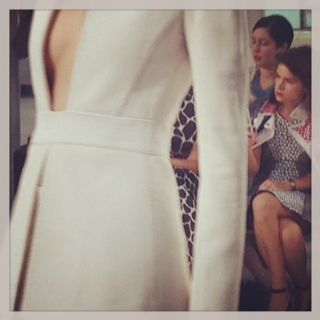Identity
Feathers and Fendi: Understanding Fashion Week
What the rites of Fashion Week tell us about Manhattan, the Fashion Tribe and us
Posted September 12, 2013
Manhattan is a town of tribes. And there is no tribe-ier tribe than the Fashion Tribe. They speak their own language, in which they express their own concerns to themselves and the rest of us who care (“Fringe is trending”; “Alexander Wang is the new Marc Jacobs” “The yellow story is holding on”). New York City, London, Milan and Paris are the tribe’s habitus. The Fashion Tribe is migratory and exotic, traveling where their Vuitton luggage and schedules take them. And they live in another timeframe—for them, it’s all about Spring/Summer 2014 in the early days of fall. But as a New Yorker, I like to think they are somehow ours, that they live with us here and now, and always will.
It almost goes without saying that members of the Fashion Tribe dress their own way. They have to and more importantly, they want to. Dressing—in Dries or The Row or Prada or Proenza or H&M—telegraphs their loyalties, their personalities, and their individual and group identity. "You dress differently at Conde Nast than at Hearst," one woman who made the transition informed me matter of factly.
There is no better, worse, more exciting and more exhausting week for the Fashion Tribe than New York Fashion Week (which, in writing, they refer to as #nyfw) (like the total outsider I am, I several times used the hashtag #fwny. Didn’t know better; don’t speak the language).
Fashion Week, which happens in the first two weeks of September in New York, is something like a giant conference or show and tell for the Fashion Tribe. Aspiring and up and coming and established designers showcase their visions in impressive, tightly choreographed and precisely timed visual spectacles.
Fashion Week is a showcase, to be sure. But it is also a cultural ritual, a rite of endurance and commitment. The editors, assistants, writers and photographers go to show after show, sometimes more than ten per day, for eight days running. They tweet about trends, sightings and the meaning of it all. They greet one another (or don't) in highly scripted ways (kissing on both cheeks is most common) and exhange information about what they have seen and where they will go next. In so doing, they affirm their tribal affiliation, demonstrate their tribal loyalty and dramatically enact their belief in not just individual designers, but the entire fashion system. Going to Fashion Week, show after show, says “This is what we do” and affirms “This is what we believe” and even more profoundly, telegraphs "This is who we are." At the Spring/Summer 2014 Proenza Schouler show I attended, many of the attendees wore white. This was in part because it was over 90 degrees that day, and white 'felt' and looked cooler to the eye. But the color white also has a long association with ceremonies and rites, particularly those of purification and identity.
In other words, Fashion Week may seem uniquely postmodern and post industrial, a mere "symptom" of consumer culture. But it isn't. In fact, it draws from other endurance rites, including those of indigenous cultures. The Sunrise Dance of the Apache people is just one example . This is a complex dance a young woman undertakes to mark her transition to adult status and womanhood. For four entire days, she dances a specific and meticulous choreography non-stop. She wears special garments and pigments to mark the sacredness and specificity of this moment in time. In so doing she demonstrates her commitment to her people, her tribe and her gender. At the end she is exhausted—and initiated. She rests for an additional four days, and emerges changed, a confirmed member of Apache womanhood.
Much the same holds for the members of the fashion tribe who participate in Fashion Week. Their initiation is re-enacted year after year, however, seasonally and in a very specific sequence and set of sacred spaces. Fashion Week is a way to demonstrate again and again that their collective rites are relevant and their creations “ever new,” as well as linked by tradition to previous shows and visionaries. Like a BBQ or a ladies’ luncheon, all of fashion week is a pro-social, affiliative ritual that bonds the fashion tribe together, orders and reorders the tribe's hierarchy (where you sit and whether you get to sit at all are crucial factors) while showing their separateness from others. The rest of us are spectators.

White, worn during rites of purification and identity transformation, at the Proenza Schouler Spring/Summer 2014 show


